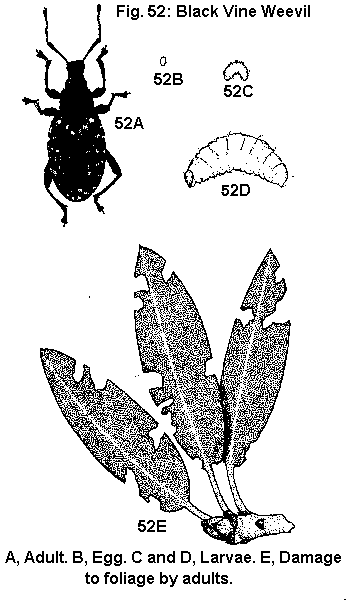Beetles (Black Vine Weevil)
Black vine weevil (Figure 52), Otiorhynchis sulcatus (Fabricius), Curculionidae, COLEOPTERA
DESCRIPTION
Adult
The adult black vine weevil is a beetle about 10 to 11 mm in length with an elongated snout. The antennae are long and slender with an obvious elbow. The wing covers are relatively rounded, with parallel ridges running lengthwise, and have patches of yellowish hair. The wing covers are fused so that the insect cannot fly.
Egg
Eggs are almost spherical and about 0.7 mm in diameter. They are pearly white when first laid and darken to a light brown in about 24 hours.
Larva
Newly hatched larvae have straight, pinkish-white bodies with brown heads. As the larva matures, the body becomes curved by the thickening of the area behind the head so that the head appears small. Mature larvae are about 7 mm long and have no legs.
Pupa
When the pupa is first formed, it is milky white with large spines on the head, legs, and abdomen. As it matures it darkens until it is almost black.
BIOLOGY
Distribution
The black vine weevil is a native of Europe. It was first noted in the United States in Massachusetts in 1835. The first report of the weevil as a pest was in 1871 from Missouri. Since its introduction, the black vine weevil has spread west to Wisconsin and Missouri, south to North Carolina, and north into Canada. It also is found in the Western United States from New Mexico north to British Columbia, Nevada, Utah, Idaho, Montana, and South Dakota.
Host Plants
The black vine weevil feeds on numerous outdoor and greenhouse plants. Some of the recorded greenhouse host plants are: asparagus fern, aster, astilbe, begonia, Boston fern, cyclamen, geranium, gloxinia, hydrangea, impatiens, primrose, and saxifrage.
Damage
The young larvae feed on small roots. As they mature, they entirely devour larger roots or cut them off. Large larvae also may bore into crowns or corms. Infested plants suddenly wilt and die because of lack of roots. Adults feed at night and notch foliage and flowers.
Life History
In the greenhouse the black vine weevil may have 2 generations each year. Eggs are laid in the soil and hatch in 15 to 21 days. Larvae feed for 3 to 4 months before pupating. The pupal cell is formed 1 to 2 inches below the soil surface. The pupal period lasts about 18 days. Adults feed for 30 days before laying eggs. Peak adult emergence is in January and February and again in August and September. All adults are females. Males are not known for this species. Because they cannot fly, they rely on man for distribution.
CONTROL
One thing to remember is not to rescue potting media from infested plants or compost the media near a greenhouse unless the mix is sterilized or pasteurized. Foliar applications of certain pesticides are effective against the adults. Soil drenches can be used to control larvae. When using soil treatments, watch for phytotoxic responses of the plants. Research has shown that soil treatments are not as effective in media with a high organic matter content. For specific chemical control recommendations, see the current Cooperative Extension publications on ornamental plant pest management or consult your county Extension agent.
Publication date: Jan. 1, 1994
AG-136
Other Publications in Insect and Related Pests of Flowers and Foliage Plants
- Aphids Found on Flowers and Foliage
- Beetles Found on Flowers and Foliage
- Bugs Found on Flowers and Foliage
- Caterpillars Found on Flowers and Foliage
- Flies and Maggots Found on Flowers and Foliage
- Leafhoppers Found on Flowers and Foliage
- Mealybugs Found on Flowers and Foliage
- Mites Found on Flowers and Foliage
- Scale Insects Found on Flowers and Foliage
- Slugs and Snails Found on Flowers and Foliage
- Thrips Found on Flowers and Foliage
- Whiteflies Found on Flowers and Foliage
N.C. Cooperative Extension prohibits discrimination and harassment regardless of age, color, disability, family and marital status, gender identity, national origin, political beliefs, race, religion, sex (including pregnancy), sexual orientation and veteran status.

